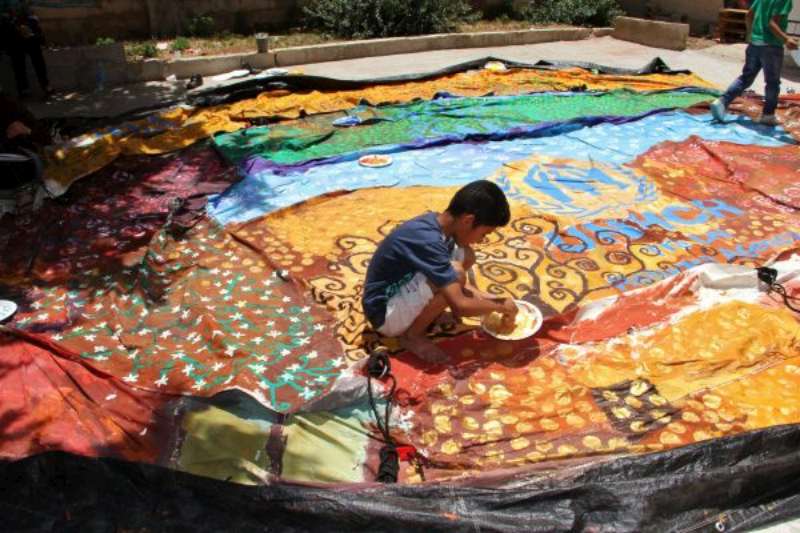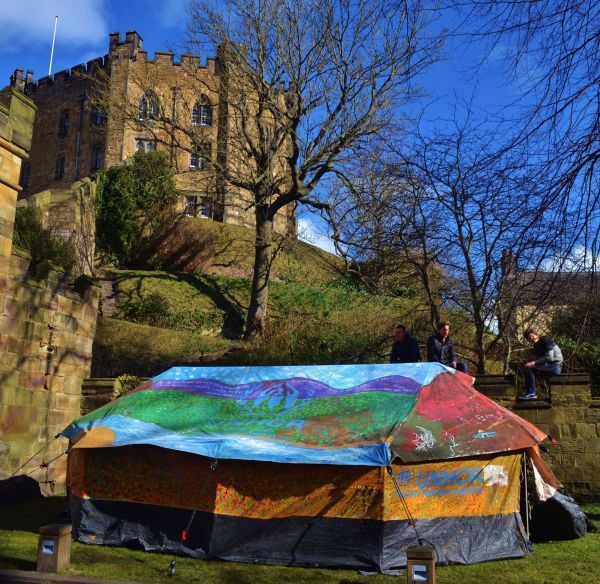
The artwork on this tent was inspired by the Austrian symbolist painter Gustav Klimt and the Syrian poet Nizar Qabbani. It was painted in the courtyard of a refugee centre in northern Jordan. © Courtesy of Hannah Rose Thomas
LONDON, United Kingdom, April 16 (UNHCR) – Ever since she was in kindergarten in the western Syria city of Homs, Ibtihaj has dreamed of becoming an artist. She aspired to one day open her own gallery and showcase her work to the world.
Now aged 12 years, Ibtihaj lives in Jordan, one of the more than 3.9 million Syrians who have been forced to flee their homes and seek shelter overseas as a result of the conflict that erupted in March 2011.
As she recently showed UNHCR visitors her latest creations, proudly displayed on her bedroom walls in the Jordanian capital, Amman, it was clear her experiences have had a big impact on her. “This is a son and his mother praying to God, asking him to help Syria,” she said. “And this is an eye crying for its country.”
Following a visit from British artist Hannah Rose Thomas to Jordan last year, Ibtihaj is set to see her dream of reaching a global audience come true. During her study trip, 23-year-old Thomas heard some of the refugees’ stories and came up with the idea of recycling old UNHCR tents as a canvas for refugees to express themselves on. The results have been so powerful that the tents are now set to be exhibited in locations across the world.
“The goal was to turn these symbols of loss and displacement into beautiful pieces of art, in order to raise awareness for the plight of refugees,” Hannah told UNHCR in London. “We played with the idea of ‘fragments’, ‘pieces’ and ‘shattered lives.’ Lives fall apart when forcefully expelled from their homes and need to be rebuilt again.”

One of the tents is exhibited below historic Durham Castle. © Courtesy of Hannah Rose Thomas
The most common image expressed by the refugees, however, was home, highlighting the longing of refugees for the conflict to end so that they can return to Syria. “My father is a farmer,” wrote 13-year-old Abdullah. “I cannot wait to work with him in the fields again, pick the fruit from our orchard and just do everything again.”
The three tents were first exhibited last year in the Jordanian capital, Amman, to commemorate World Refugee Day (June 20) and have proven so popular they are now set for global exposure.
One of the tents has already been exhibited in Belgium, and two of them were earlier this year used to help launch the “Brighter Lives for Refugees” campaign in the United Kingdom, a UNHCR partnership with the IKEA Foundation to bring sustainable energy to refugee camps in Jordan, Chad, Bangladesh and Ethiopia.
The tents were recently exhibited at various locations around the historic north-eastern town of Durham. In June, one will be pitched on London’s Southbank as part of the Refugee Week celebrations while the other will be heading for Geneva to be used as part of the celebrations commemorating World Refugee Day on June 20 and the 70th anniversary of the United Nations.
Art has been shown to be a great way for refugees to understand and express their experiences. Many refugees find the creative process to be cathartic and helpful in counteracting psycho-social problems that may otherwise develop as a result of the trauma they have faced when forced to flee their homes.
“There is a liberating element of art,” said Hannah. “Free and safe spaces are important for children who might feel trapped by their trauma. The art projects provided a rare chance for the refugees to express themselves and helped with collectively processing the ordeals they have experienced.”
By Charlie Ya


